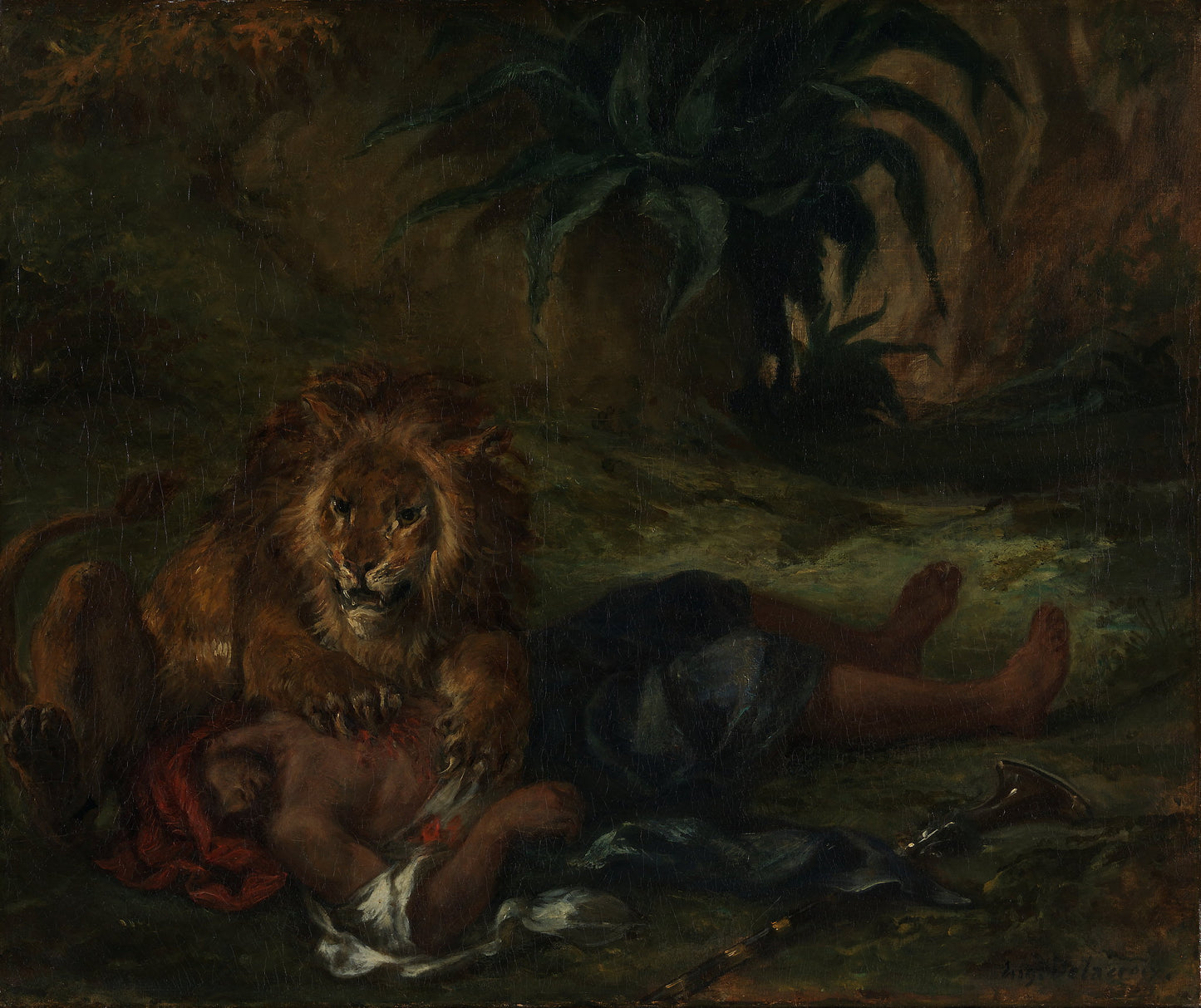Eugène Delacroix
The lion in his den
The lion in his den
Couldn't load pickup availability
High-quality reproductions from the National Museum's collection. Posters by DAIDDA are printed on Litho White Matt - 230 gram photo paper in premium quality. Artprints by DAIDDA are printed on Moab Entrada Natural 300 gram cotton art paper in premium quality. Produced by DAIDDA.
About the original:
Date: (1847)
Other titles: Le lion dans son antre (FRA)
The Lion in His Lair (ENG)
Lion et l'Homme mort (FRA)
Designation: Painting
Material and technique: Oil on canvas
Technique: Oil
Material: Canvas
Dimensions: 54.4 x 65.7 cm
Subject: Visual arts
Classification: 532 - Visual arts
Motif: Animals
Type of motif: Hunting scene
Acquisition: Gift from the Friends of the National Gallery 1918
Inventory no.: NG.M.01178
Part of exhibition: The dance of life. The collection from antiquity to 1950, 2011 - 2019
Older foreign art before 1915 from the National Gallery's collection, 2007 - 2008
French Painting from David to Courbet, 1928
French painting of the 19th century, 1914
Registration level: Single object
Owner and collection: The National Museum of Art, Architecture and Design, Visual Art Collections
Photo: Ivarsøy, Dag Andre
Shipping and returns
Shipping and returns
Shipping: We deliver to Scandinavia, the EU, the USA and several other countries. Please contact us if your country is not listed and we will try to arrange delivery.
Delivery time: 2-5 days within Norway, 7 days in Europe, 14 days globally.
Packaging: Our products are made to order and sent rolled in environmentally friendly packaging.
Customs Fees: International orders may be subject to customs fees, which are not included in shipping costs.
Return policy: You can return images within 14 days. See our returns page for more information.
Secure Payment: We never store your payment details. See our privacy policy for details.

See all works
-
The lion in his den
Vendor:Eugène DelacroixRegular price From 150,00 NOKRegular priceUnit price per -
White and a red peony
Vendor:Eugène DelacroixRegular price From 150,00 NOKRegular priceUnit price per

Eugene Delacroix
Visual artist. Born 1798 in Charenton, died 1863 in Paris, France. Eugène Delacroix was a French painter and the greatest colorist of Romanticism. He grew up in Marseille and Bordeaux, but in 1805 went to Paris with his mother. Here he became an early pupil of PierreNarcisse Guérin, and was influenced by his fellow pupil Théodore Géricault.
Like Géricault and Pierre Paul Prud'hon, he fought academic classicism. Delacroix first exhibited at the Salon in 1822 with Dante and Vergil and in 1824 with the Massacre at Chios. These paintings gave rise to heated debate between classicists and romanticists. In 1824, he was so excited by John Constable's painting "The High Wagon", that he reworked his own image and acquired the technique of the pure color spots, which would later become so important to Impressionism. He had also become acquainted with the English painter Richard Parks Bonington, traveled to London to study English painting, especially Constable. At the Salon in 1827, he exhibited the paintings: Christ on the Mount of Olives, Doge Marino Falieri's beheading and the death of Sardanapalus, and in 1830 the barricade battle on 28 July. Freedom leads the people (Louvre). Delacroix's first romantic period (1822–1831) ends with a trip to Morocco and Algeria in 1832. During this time he often painted oriental subjects, but also subjects from the Bible, history, mythology, poetry (Dante, Shakespeare, Ariosto, Byron, Goethe, Walther Scott) and from everyday life. He is also known for his animal paintings, Tiger Hunt (1854), Horse Fight (1860) and The Lioness (1863). Delacroix's last major work was the monumental paintings in the chapel of Saint-Sulpice in Paris (1855–1861): the frescoes The Expulsion of Helidorus and Jacob's Struggle with the Angel. Here, the colors are set down in fresh, immediate strokes, and these latest works point towards impressionism. Although his pictures are compositionally based on older traditions, their dynamic movement, their free brushwork and especially their coloristic strength gained ground-breaking importance for later art trends, coloristically and technically, not least for Impressionism and Neo-Impressionism.
Delacroix also discovered a law that he called the law of binary colors. It is based on the intensity increase of the colors through simultaneous contrast and on maximum power through primary triad: red, green, yellow. He often used complementary colors and put blue against yellow and red against green. The publication of his letters and diaries caused a great stir; an extract from his diaries was published in Norwegian in 1954. The Musée Delacroix is located in a garden in St. Germain-des-Prés (Paris) and has sketches, prints and oil paintings by the artist. He lived and worked here 1857–1863. The apartment on the second floor and the studio in the garden now form a national museum, where exhibitions of his paintings are regularly held. The National Gallery in Oslo owns The Lion tearing a dead man to pieces, Jesus on the Sea of Galilee and Helidor driven out of the temple.



